![]()

The Desert Song (1929)
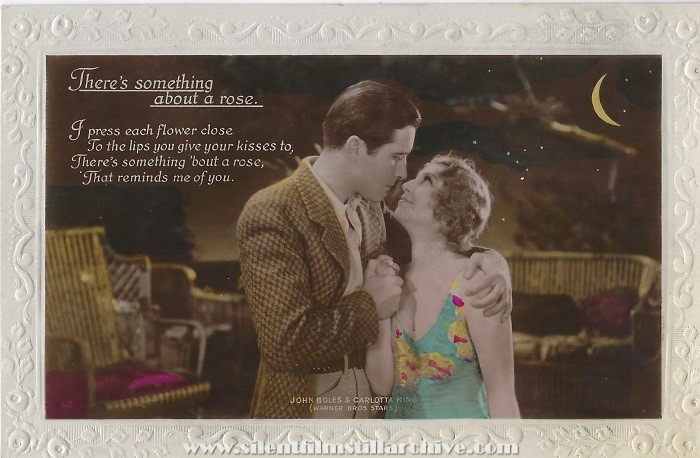
There's something about a rose.
I press each flower close
To the lips you give your
kisses to,
There's something 'bout a rose,
That reminds me of you.
40 JOHN BOLES & CARLOTTA KING
(Warner Bros. Stars)
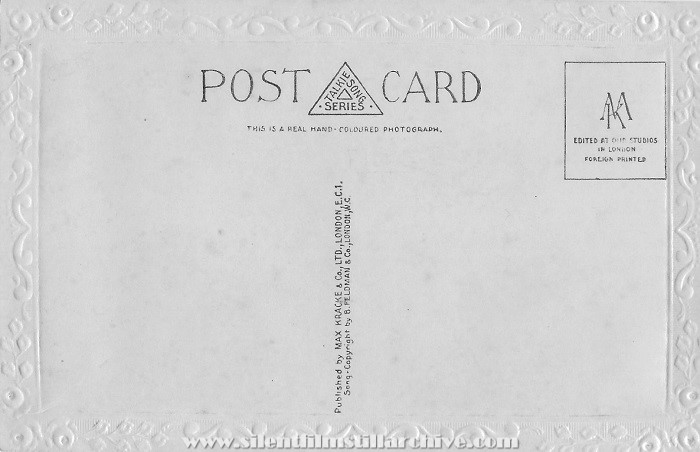
POST CARD
TALKIE SONG SERIES
This is a real hand-coloured
Photograph.
Published by MAX KRACKE & Co., LTD. London E. C. 1.
Song Copyright by B. FELDMAN & Co., London, W. C.
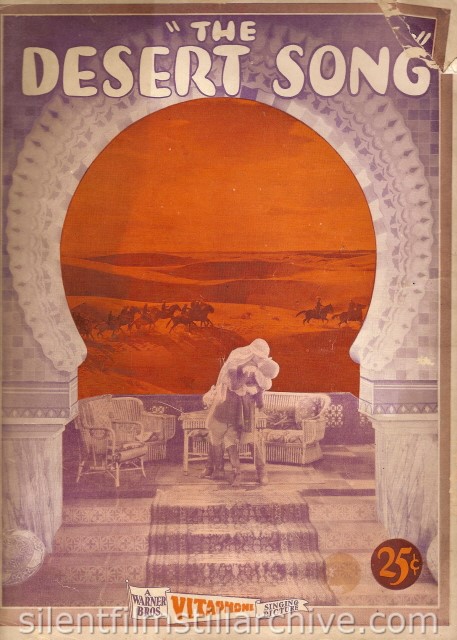
A Warner Bros. Vitaphone Singing Picture
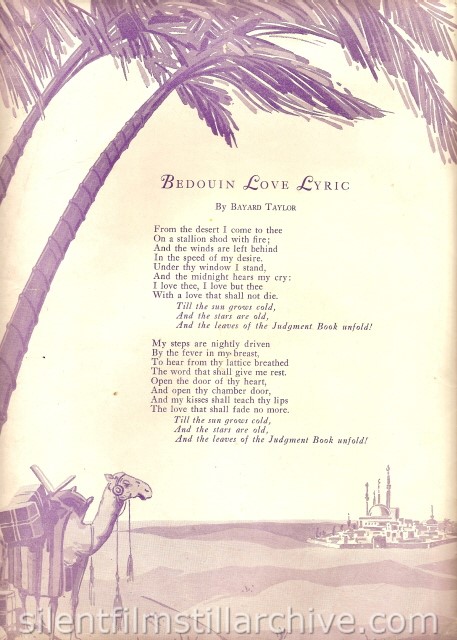
BEDOIN LOVE LYRIC
By Bayard Taylor
From the desert I come to thee
On a stallion shod with
fire;
And the winds are left behind
In the speed of my desire.
Under thy window I stand,
And the midnight hears my cry:
I love thee,
I love but thee
With a love that shall not die.
Till the sun grows cold,
And the stars are old,
And the leaves of the Judgment Book unfold!
My steps are nightly driven
By the fever in my breast,
To hear from thy lattice breathed
The word that shall give me rest.
Open the door of thy heart,
And open thy chamber door,
And my kisses
shall teach thy lips
The love that shall fade no more.
Till the sun grows cold,
And the stars are old,
And the leaves of the Judgment Book unfold!
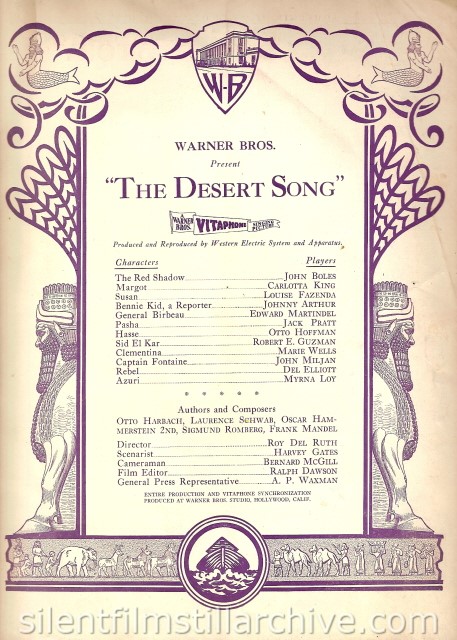
WARNER BROS. present
"THE DESERT SONG"
A Warner Brothers Vitaphone Singing Picture
Produced and Reproduced by Western Electric System and Apparatus.
|
Characters |
Players |
|
The Red Shadow |
John Bowles |
|
Margot |
Carlotta King |
|
Susan |
Louise Fazenda |
|
Bennie Kid, a Reporter |
Johnny Arthur |
|
General Birbeau |
Edward Martindel |
|
Pasha |
Jack Pratt |
|
Hasse |
Otto Hoffman |
|
Sid El Kar |
Robert E. Guzman |
|
Clementina |
Marie Wells |
|
Captain Fontaine |
John Miljan |
|
Rebel |
Del Elliott |
|
Azuri |
Myrna Loy |
* * * * *
Authors and Composers
OTTO HARBACH, LAURENCE SCHWAB, OSCAR HAMMERSTEIN 2ND, SIGMUND ROMBERG, FRANK MANDEL
|
Director |
Roy Del Ruth |
|
Scenarist |
Harvey Gates |
|
Cameraman |
Bernard McGill |
|
Film Editor |
Ralph Dawson |
|
General Press Representative |
A. P. Waxman |
ENTIRE PRODUCTION AND VITAPHONE SYNCHRONIZATION PRODUCED AT WARNER BROS. STUDIO, HOLLYWOOD, CALIF.
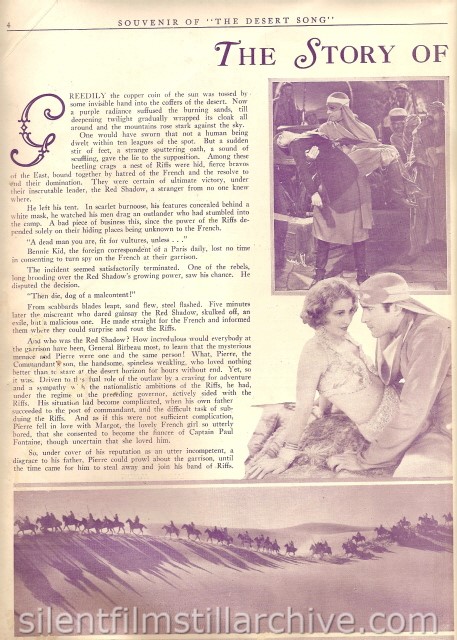
THE STORY OF "THE DESERT SONG"
GREEDILY the copper coin of the sun was tossed by some invisible hand into the coffers of the desert. Now a purple radiance suffused the burning sands, till deepening twilight gradually wrapped its cloak all around and the mountains rose stark against the sky.
One would have sworn that not a human being dwelt within ten leagues of the spot. But a sudden stir of feet, a strange sputtering oath, a sound of scuffling, gave the lie to the supposition. Among these beetling crags a nest of Riffs were hid, fierce bravos of the East, bound together by hatred of the French and the resolve to end their domination. They were certain of ultimate victory, under their inscrutable leader, the Red Shadow, a stranger from no one knew where.
He left his tent. In scarlet burnoose, his features concealed behind a white mask, he watched his men drag an outlander who had stumbled into the camp. A bad piece of business this, since the power of the Riffs depended solely on their hiding places being unknown to the French.
"A dead man you are, fit for vultures, unless ..."
Bennie Kid, the foreign correspondent of a Paris daily, lost no time in consenting to turn spy on the French at their garrison.
The incident seemed satisfactorily terminated. One of the rebels, long brooding over the Red Shadow's growing power, saw his chance. He disputed the decision.
"Then die, dog of a malcontent!'
From scabbords blades lept, sand flew, steel flashed. Five minutes later the miscreant who dared gainsay the Red Shadow, skulked off, an exile, but a malicious one. he made straight for the French and informed them where they could surprise and rout the Riffs.
And who was the Red Shadow? How incredulous would everybody at the garrison have een, General Birbeau most, to learn that the mysterious menace and Pierre were one and the same person! What, Pierre, the Commandant's son, the handsome, spineless weakling, who loved nothing better than to stare at the desert horizon for hours without end. Yet, so it was. Driven to this dual role of the outlaw by a craving for adventure and a sympathy with the nationalistic ambitions of the Riffs, he had, under the regime of the preceding governor, actively sided with the Riffs. His situation had become complicated, when his own father succeeded to the post of commandant, and the difficult task of subduing the Riffs. And as if this were not sufficient complication, Pierre fell in love with Margot, the lovely French girl so utterly bored, that she consented to become the fiancee of Captain Paul Fontaine, though uncertain that she loved him.
So, under cover of his reputationas an utter incompetent, a disgrace to his father, Pierre could prowl about the garrison, until the time came for him to steal away and join his band of Riffs.
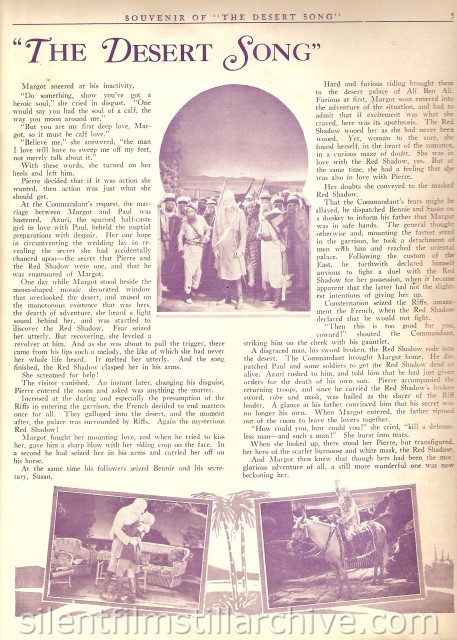
Margot sneered at his inactivity.
"Do something, show you've got a heroic soul," she cried in disgust. "One would say you had the sould of a calf, the way you moon around me."
"But you are my first deep love, Margot, so it must be calf love."
"Believe me," she answered, "the man I love will have to sweep me off my feet, not merely talk about it."
With these words, she turned on her heels and left him.
Pierre decided that if it was action she wanted, then action was just what she should get.
At the Commandant's request, the marriage between Margot and Paul was hastened. Azuri, the spurned half-caste girl in love with Paul, behend the nuptial preparations with despair. Her one hope in circumventing the wedding lay in revealing the secret she had accidentally chanced upon -- the secret that Pierre and the Red Shadow were one, and that he was enamoured of Margot.
One day while Margot stood beside the moon-shaped mosaic decorated window that overlooked the desert, and mused on the monotonous existence that was hers, the dearth of adventure, she heard a light sound behind her, and was startled to discover the Red Shadow. Fear seized her utterly. But recovering, she leveled a revolver at him. And as she was about to pull the trigger, there came from his lips such a melody, the like of which she had never her whole life heard. It melted her utterly. And the song finished, the Red Shadow clasped her in his arms.
She screamed for help!
The visitor vanished. An instant later, changing his disguise, Pierre entered the room and asked was anything the matter.
Incensed at the daring and especially the presumption of the Riffs in entering the garrison, the French decided to end matters once and for all. They galloped into the desert, and the moment after, the palace was surrounded by Riffs. Again the mysterious Red Shadow!
Margot fought her mounting love, and when he tried to kiss her, gave him a sharp blow with her riding crop on the face. In a second he had seized her in his arms and carid her off on his horse.
At the same time his followers seized Bennie and his secretary, Susan.
Hard and furious riding brought them to the desert palace of Ali Ben Ali. Furious at first, Margot soon entered into the adventure of the situation, and had to admit that if excitement wsa what she craved, here was its apotheosis. The Red Shadow wooed her as she had never been wooed. Yet, woman to the core, she found herself, in the heart of the romance, in a curious maze of doubt. She was in love with the Red Shadow, yes. But at the same time, she had a feeling that she was also in love with Pierre.
Her doubts she conveyed to the masked Red Shadow.
That the Commandant's fears might be allayed, he dispatched Bennie and Susan on a donkey to inform his father that Magot was in safe hands. The general thought otherwise and, mounting the fastest steed in the garrison, he took a detachment of men with him and reached the oriental palace. Following the custom of the Est, he forthwith declared himself anxious to fight aduel with the Red Shadow for her possession, when it became apparent that the latter had not the slightest intentions of giving her up.
Consternation seized the Riffs, amazement the French, when the Red Shadow declared that he would not fight.
"Then this is too good for you, coward!" shouted the Commandant, striking him on the cheek with his gauntlet.
A disgraced man, his sword broken, the Red Shadow rode into the desert. The Commandant brought Margot home. He dispatched Paul and some soldiers to get the Red Shadow dead or alive. Azuri rushed to him, and told him that he had just given orders for the death of his own son. Pierre accompanied the returning troops, and since he carried the Red Shadow's broken sword, robe and mask, was hailed as the slayer of the Riff leader. A glance at his father convinced him that his secret was no longer his own. When Margot entered, the father tiptoed out of the room to leave the lovers together.
"How could you, how could you!" she cried, "kill a defenseless man -- and such a man!" She burst into tears.
When she looked up, there stood her Pierre, but transfigured, her hero of the scarlet burnoose and white mask, the Red Shadow.
And Margot then knew that though hers had been the most glorious adventure of all, a still more wonderful one was now beckoning her.
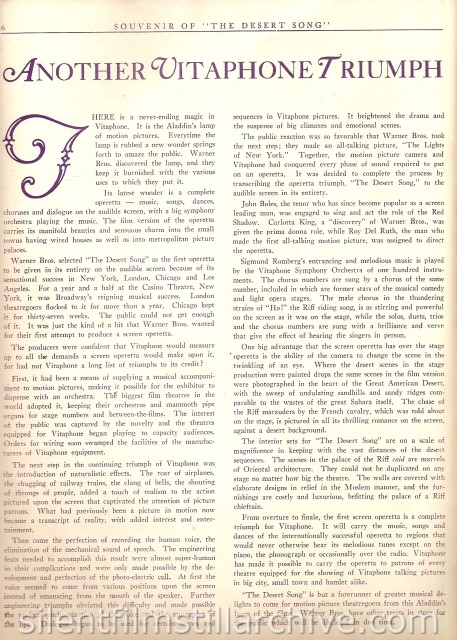
ANOTHER VITAPHONE TRIUMPH
There is a never-ending magic in Vitaphone. It is the Aladdin's lamp of motion pictures. Everytime the lamp is rubbed a new wonder springs forth to amaze the public. Warner Bros. discovered the lamp, and they keep it burnished with the4 various uses to which they put it.
It's latest wonder is a complete operetta -- music, songs, dances, choruses and dialogue on the audible screen, with a big symphony orchestra playing the music. The film version of the operetta carries its manifold beauties and sensuous charm into the small towns having wired houses as well as into metropolitan picture palaces.
Warner Bros. selected "The Desert Song" as the first operetta to be given in its enirety on the audible screen because of its sensational success in New York, London, Chicago, and Los Angeles. For a year and a half at the Casino Theatre, New York, it was Broadway's reigning musical success. London theatregoers flocked to it for more than a year. Chicago kept it for thirty-seven weeks. The public could not get enough of it. It was just the kind of a hit that Warner Bros. wanted for their first attemp to produce a screen operetta.
The producers were confident that Vitaphone would measure up to all the demands a screen operetta would make upon it, for had not Vitaphone a long list of triumphs to its credit?
First, it had been a means of supplying a musical accompaniment to motion pictures, making it possible for the exhibitor to dispense with an orchestra. The biggest film thetres in the world adopted it, keeping their orchestras and mammoth pipe organs for stage numbers and between-the-films. The interest of the public was captured by the novelty and the theatres equipped for Vitaphone began playing to capacity audiences. Orders for wiring soon swamped the facilities of the manufacturers of Vitaphone equipment.
The next step in the continuing triumph of Vitaphone was the introduction of naturalistic effects. The roar of airplanes, the chugging of railway trains, the clang of bells, the shouting of throngs of people, added a touch of realism to the action pictured upon the screen that captivated the attention of picture patrons. What had previously been a picture in motion now became a transcript of reality, with added interest and entertainment.
Then came the perfection of recording the human voice, the elimination of the mechanical sound of speech. The engineering feats needed to accomplish this result were almost super-human in their complications and were only made possible by the development and perfection of the photo-electric cell. At first the voice seemed to come from various positions upon the screen instead of emanating from the mouth of the speaker. Further engineering triumphs obviated this difficulty and made possible the perfect synchronization of the voice and the movement of the lips. Dialogue began to be used for certain scenes and sequences in Vitaphone pictures. It heightened the drama and the suspense of big climaxes and emotional scenes.
The public reaction was so favorable that Warner Brothers took the next step; then made an all-talking picture, "The Lights of New York." Together, the motion picture camera and Vitaphone had conquered every phase of sound required to put on an operetta. It was decided to complete the process by transcribing the operetta triumph, "The Desert Song," to the audible screen in its entirety.
John Boles, the tenor who has since become popular as a screen leading man, was engaged to sing and act the role of the Red Shadow. Carlotta King, a "discovery" of Warner Brothers, wsa given the prima donna role, while Roy Del Ruth, the man who made the first all-taling motion picture, wsa assigned to direct the operetta.
Sigmund Romberg's entrancing and melodious music is played by the Vitaphone Symphony Orchestra of one hundred instruments. The chorus numbers are sung by a chorus of the same number, included in which are former stars of the musical comedy and light opera stages. The male chorus in the thundering strains of "Ho!" the Riff riding song, is as stirring and powerful on the screen as it was on the stage, while the solos, duets, trios and the chorus numbers are sung with a brilliance and verve that give the effect of hearing the singers in person.
One big advantage that the screen operetta has over the stage operetta is the ability of the camera to change the scene in the twinkling of an eye. Where the desert scenes in the stage production were painged drops the same scenes in the filmversion were photographed in the heart of the great American desert, with the sweep of undulating sandhills and sandy ridges comparable to the wastes of the great Sahara itself. The chase of the Riff marauders by the French cavalry, which was told about on the stage, is pictured in all its thrilling romance on the screen, against a desert background.
The interior sets for "The Desert Song" are on a scale of magnificence in keeping with the vast distances of the desert sequences. The scenes in the palace of the Riff caid are marvels of Oriental architecture. They could not be duplicated on any stage no matter how big the theatre. The walls are covered with elaborate designs in relief in the Moslem manner, and the furnishings are costly and luxurious, befitting the palace of a Riff chieftain.
From overture to finale, the first screen operetta is a complete triumph for Vitaphone. It will carry the music, songs and dances of the internationally successful operetta to regions that would never otherwise hear its melodious tunes except on the piano, the phonograph or occasionally over the radio. Vitaphone has made it possible to carry the operetta to patrons of every theatre equipped for the showing of Vitaphone talking pictures in a big city, small town and hamlet alike.
"The Desert Song" is but a forerunner of greater musical delights to come for motion picture theatregoers from this Aladdin's lamp of the films. Warner Brothers have other treats in store for the public which will be disclosed in due time.
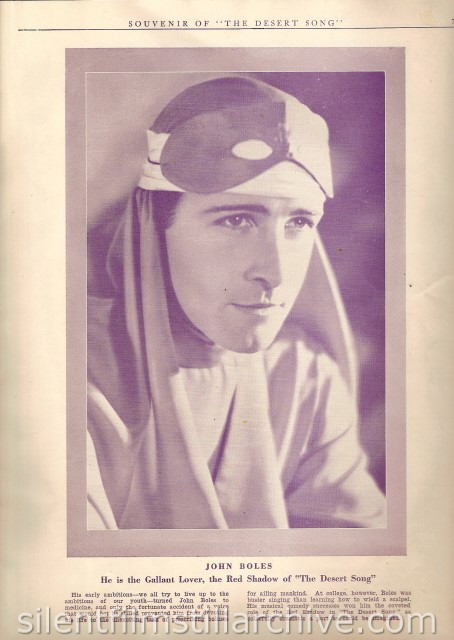
JOHN BOLES
He is the Gallant Lover, the Red Shadow of "The Desert Song"
His early ambitions -- we all try to live up to the ambitions of our youth -- turned John Boles to medicine, and on the fortunate accident of a voice that would not be stilled prevented him from devoting his life to the unexciting task of prescribing boluses for ailing mankind. At college, however, Boles was busier singing than learning how to wield a scalpel. His musical comedy successes won him the coveted role of the Red Shadow in "The Desert Song," as colorfully dramatic a part as could be imagined.
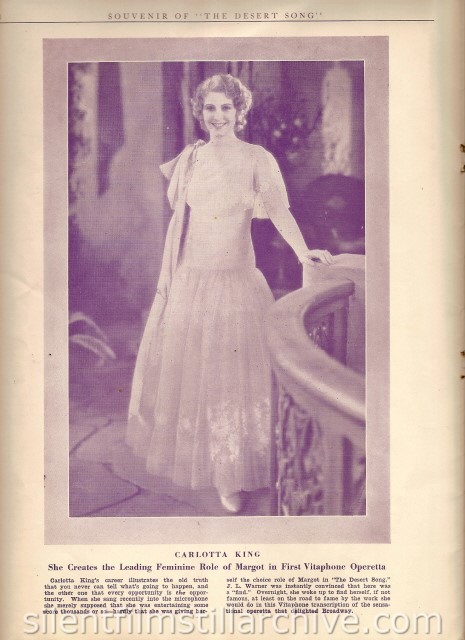
CARLOTTA KING
She Creates the Leading feminine Role of Margot in First Vitaphone Operetta
Carlotta King's career illustrates the old truth that you never can tell what's going to happen, and the other one that every opportunity is the opportunity. When she sang recently into the microphone she merely supposed that she wsa entertaing some score thousands or so -- hardly that she wsa giving herleft the choice role of Margot in "The Desert Song." J.L. Warner wsa instantly convinced that here was a "find." Overnight, she woke up to find herself, if not famous, at elast on the road to fame by the work she would do in this Vitaphone transcription of the sensational operetta that delighted Broadway.
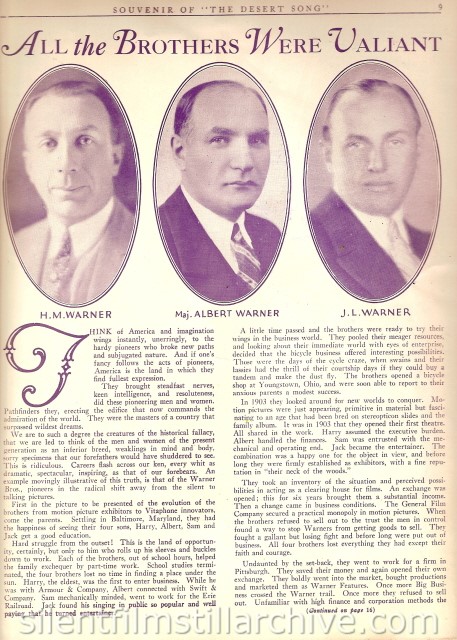
All the Brothers Were Valiant
Think of America and imagination wings instantly, unerringly, to the hardy pioneers who broke new paths and subjugated nature. And if one's fance follows the acts of pioneers, American is the land in which they find fullest expression.
They brought steadfast nerves, keen intelligence, and resoluteness, did these pioneering mena and women. Pathfinders they, erecting the edifice that now commands the admiration of the world. They were the masters of a country that surpassed wildest dreams.
We are to such a degree the creatures of the historical fallacy, that we are led to think of the men and women of the present generation as an inferior breed, weaklings in mind and body, sorry specimens that our forefathers would have shuddered to see. This is ridiculous. Careers flash across our ken, every whit as dramatic, spectacular, inspiring, as that of our forebears. An example moving illustrative of this truth, is that of the Warner Brothers, pioneers in the radical shift away fromt he silent to talking pictures.
First in the picture to be presented of the evolutionof the brothers from motion picture exhibitors to Vitaphone innovators, come the parents. Settling in Baltimore, Maryland, they had the happiness of seeing their four sons, harry, Albert, Sam and Jack get a good education.
Hard struggle from the outset! This is the land of opportunity, certainly, but only to him who rolls up his sleeves and buckles down to work. Each of the brothers, out of school hours, helped the family exchequer by part-time work. School studies terminated, the four brothers lost no time in finding a place under the sun. Harry, the eldest, was the first to enter business. While he was with Armour & Company, Albert connected with Swift and Company. Sam mechanically minded, went to work for the Erie Railroad. Jack found his singing in public so popular and well paying that he turned entertainer.
A little time passed and the brothers were ready to try their wings in the business world. They pooled their meager resources, and looking about their immediate world with eyes of enterprise, decided that the bicycle business offered interesting possibilities. Those were the days of the cycle craze, when swains and their lassies had the thrill of their courtship days if they could buy a tandem and make the dust fly. The brothers opened a bicycle shop at Youngstown, Ohio, and were soon able to report to their ansious parents a modest success.
In 1903 they looked around for new worlds to conquer. Motion pictures were just appearing, primitive in material but fascinating to an age that had been bred on stereopticon slides and the family album. It was in 1903 that they opened their first theatre. All shared in the work. Harry assumed the executive burden. Albert handled the finances. Sam was intrusted with the mechanical and operating end. Jack became the entertainer. The combination was a happy one for the object in view, and before long they were firmly established as exhibitors, with a fine reputation in "their neck of the woods."
They took an inventory of the situation and preceived possibilities in acting as a clearing house for films. An exchange was opened; this for six years brought them a substantial income. Then a change came in business conditions. The General Film Company secured a prectiacl monopoly in moation pictures. When the brothers refused to sell out to the rust the men in control found a way to stop Warners from getting goods to sell. They fought a gallant but losing fight and before long were put out of business. All four brothers lost everyhing they had except their faith and courage.
Undaunted by the set-back, they went to work for a firm in Pittsburgh. They saved their money and again opened their own exchange. They boldly went into the market, bought productions and marketed them as Warner Features. Once more Big Business crossed the Warner trail. Once more they refused to sell out. Unfamaliar with high finance and corporation methods the
(Continued on page 16)
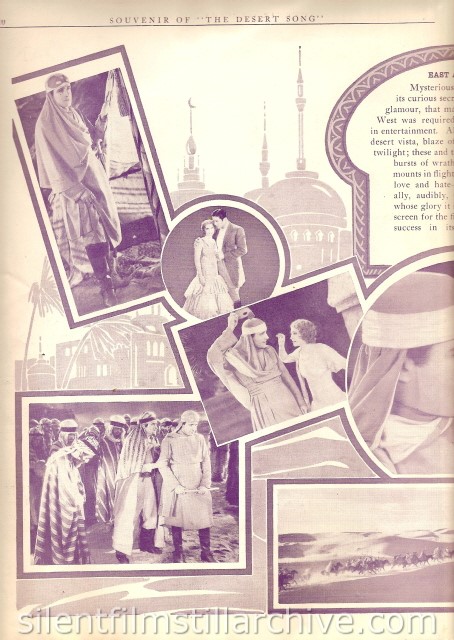
EAST and WEST
Mysterious East, guarding its curious secrets! To capture its glamour, that magical invention of the West was required -- Vitaphone, last word in entertainment. All that changing beauty of desert vista, blaze of high noon and orpor of twilight; these and the babel of tribesmen, out-bursts of wrath, careering of Arab mounts in flight, strange melodies of love and hate -- all captured visually, audibly, through Vitaphone, whose glory it is to transpost to the screen for the first time an operetta success in its flawless entirety.
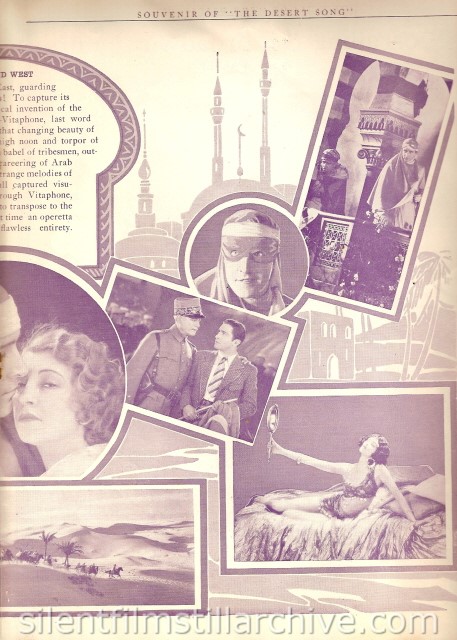
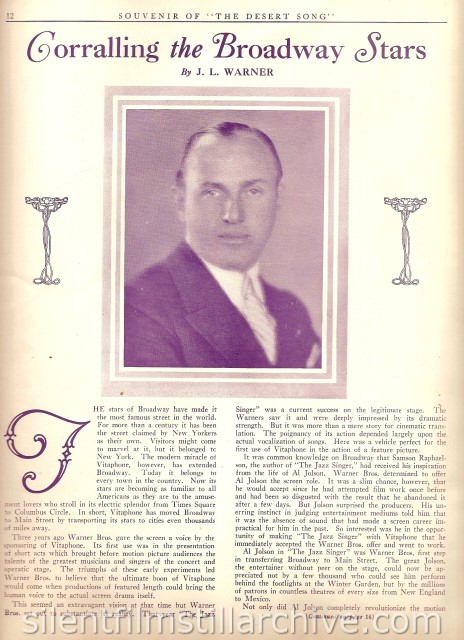
Corralling the Broadway Stars by J. L. Warner
The stars of Broadway have made it the most famous street in the world. For more than a century is has been the street claimed by New Yorkers as their own. Visitors might come to marvel at it, but it belonged to New York. The modern miracle of Vitaphone, however, has extended Broadway. Today it belongs to every town in the country. Now its stars are becoming as familiar to all Americans as they are to the amusement lovers who stroll in its electric splendor from Times Square to Columbus Circle. In short, Vitaphone has moved Broadway to Main Street by transporting its swtars to cities even thousands of miles away.
Three years ago Warner Brothers gave the screen a voice by the sponsoring of Vitaphone. Its first use was in the presentation of short acts which brought before motion picture audiences the talents of the greatest musicians and singers of the concert and operatic stage. The triumphs of these early experiements led Warner Brothers to believe that the ultimate boon of Vitaphone would come when productions of featured length could bring the human voice to the actual screen drama itself.
This seemed an extravagant vision at that time but Warner Brothers set out to substantiate its reality. That year "The Jazz Singer" was a current success on the legitimate stage. The Warners saw it and were deeply impressed by its dramatic strength. But it was more than a mere story for cinematic translation. The pognancy of its action depended largely upon the actual vocalization of songs. Here was a vehicle perfect for the first use of Vitaphone in the action of a feature picture.
It was common knowledge on Broadway that Samson Raphaelson, the author of "The Jazz Singer," had received his inspiration from the life of Al Jolson. Warner Brothers determined to offer Al Jolson the screen role. It was a slim chance, however, that he would accept since he had attempted film work once before and had been so disgusted with the result that he abandoned it after a few days. But Jolson surprised the producers. His unerring instinct in judging entertainment mediums told him that it was the absence of sound that had made a screen career impractical for him in the past. So intere3sted was he in the opportunity of making "The Jazz Singer" with Vitaphone that he immediately accepted the Warner Brothers offer and went to work.
Al Jolson in "The Jazz Singer" was Warner Brothers first step in transferring Broadway to Main Street. The great Jolson, the entertainer without peer on the stage, could now be appreciated not by a few thousand who could see him perform behind the footlights at the Winter Garden, but by the millions of patrons in countless theatres of every size from New England to Mexico.
Not only did Al Jolson completely revolutionize the motion
(continued on page 16)
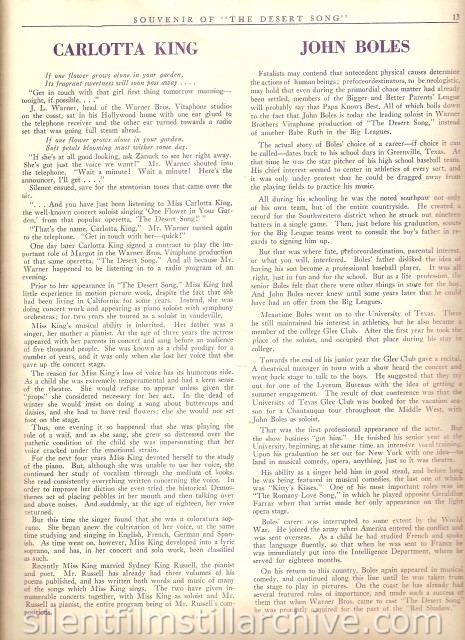
Carlotta King
If one flower grows alone in your garden,
Its fragrant sweetness will soon pass away....
"Get in touch with that girl first thing tomorrow morning -- tonight, if possible..."
J. L. Warner, head of the Warner Brothers Vitaphone studios on the coast, sat in his Hollywood home with one ear glued to the telephone receiver and the other ear turned towards a radio set that was going full steam ahead.
If one flower grows alone in your garden,
Soft petals blooming must wither some day.
"If she at all good looking, ask Zanuck to see her right away. She's got just the voice we want!" Mr. Warner shouted into the telephone. "Wait a minute! Wait a minute! Here's the announcer, I'll get ...."
Silence ensued, save for the stenotorian tones that came over the air.
"... And you have just been listening to Miss Carlotta King, the well-known concert soloist singing 'One Flower in Your Garden,' from that popular operatta, 'The Desert Song!'"
"That's the name, Carlotta King." Mr. Warner turned again to the telephone. "Get in touch with her -- quick!"
One day later Carlotta King signed a contract to play the important role of Margot in the Warner Brothers Vitatphone production of that same operetta, "The Desert Song." And all because Mr. Warner happened to be listening in to a radio program of an evening.
Prior to her appearance in "The Desert Song," Miss King had little experience in motion picture work, despite the fact that she had been living in California for some years. Instead, she was doing concert work and appearing as piano soloist with symphony orchestras; for two years she toured as a soloist in vaudeville.
Miss King's musical ability is inherited. Her father wsa a singer, her mother a pianist. At the age of three years the actress appeared with her parents in concert and sang before an audience fo five thousand people. She was known as a child prodigy for a number of years, and it was only when she lost her voice that she gave up the concert stage.
The reason for Miss King's loss of voice has it humorous side. As a child she was extremely temperamental and had a keen sense of the theatre. She would refust to appear unless given the "props" she considered necessary for her act. In the dead of winter she would insist on doing a song about buttercups and daisies, and she had to have real flowers; else she would not set foot on the stage. Thus one evening it so happened that she wsa playing the role of a waif, and as she sang, she grew so sidtressed over the pathetic condition of the child she was impersonating that her voice cracked under the emotional strain.
For the next four years Miss King devoted herself to the study of the piano. But, although she was unable to use her voice, she continued her study of vocalism through the medium of books. She read consistently everthing written concerning the voice. In order to improve her diction she even tried the historical Demosthenes act of placing pebbles in her mouth and then talking over and above noises. And suddently, at the age of eighteen, her voice returned.
But this time the singer foudn that she was a coloratura soprano. She began anew the cultivation of her voice, at the same tiem studying and singing in English, French, german and Spanish. As time went on, however, Miss King developed into a lyric soprano, and has, in her concert and solo work, been classified as such.
Recently, Miss King married Sydney King Russell, the pianist and poet. Mr. Russell has already had three volumes of his poems published, and has written both words and music of many of the songs which Miss King sings. The two have given innumerable concerts together, with Miss King as soloist and Mr. Russell as pianist, the entire program being of Mr. Russell's compositions.
John Boles
Fatalists may contend that antecedent physical causes determine the actions of human beings; preforeordestinators, to be neologistic, may hold that even during the primordial chaos matter had aready been settled,, member of the Bigger and better Parents' League will probably say that Papa Knows Best.
The actual story of Boles' choice of a career -- if choice it can be called -- dates back to his school days in Greenville, Texas. At that time he was the star pitcher of his high school baseball team. His chief interest seemed to center in athletics of every sort, and it was only under protest that he could be dragged away from the playing fields to practice his music.
All during his schooling he wsa the noted southpaw not only of his own team, but of the entire countryside. He created a record for the Southwestern district when he struck out nineteen batters in a single game. Then, just before his graduation, scouts for the Big League teams went to consult the boy's father in regards to signing him up.
But that was where fate, preforeordestination, parental interest, or what you will, interfered. Boles' father disliked the idea of having his son become a professional baseball player. It was all right, just in fun and for the school. But as a life profession, the senior Boles felt that there were other things in store for the boy. And John Boles never knew until some years later that he could have had an offer from the Big Leagues.
Meantime Boles went on to the University of Texas. There he still maintained his interest in athletics, but he also became a member of the college Glee Club. After the first year he took the place of the soloist, and occupied that place during his stay in college.
Towards the end of his junior year the Glee Club gave a recital. A theatrical manager in town with a show heard the concert and went back stage to talk to the boys. He suggested that they try out for one of the Lyceum Bureaus with the idea of getting a summer engagement. The result of that conference wsa that the University of Texas Glee Club was booked for the vacation season for a Chautaque tour through the Middle West, with John Boles as a soloist.
That was the first professional appearance of the actor. But the show business "got him." He finished his senior year at the University, beginning, at the same time, an intensive vocal training. Upon his graduation he set out for New York with one idea -- to land in musical comedy, opera, andthing, just so it was theatre.
His ability as a singer held him in good stead, and before long he was being featured in musical comedies, the last one of which was "Kitty's Kisses." One of his most important roles was in "The Romany Love Song," in which he played opposite Geraldine Farrar when that artist made her only appearance on the light opera stage.
Boles' career was interrupted to some extent by the World War. He joined the Army when America entered the conflict and was sent overseas. As a child he had studied French and spoke that language fluently, so that when he was sent to france he was immediately put into the Intelligence Department, where he served for eighteen months.
On his return to this country, Boles again appeared in musical comedy, and continued along this line until he was taken from the stage to play in pictures. On the coase he has already had several featured roles of importance, and made such a success of them that when Warner Brothers came to case "The Desert Song" he was promptly acquired for the part of the "Red Shadow".
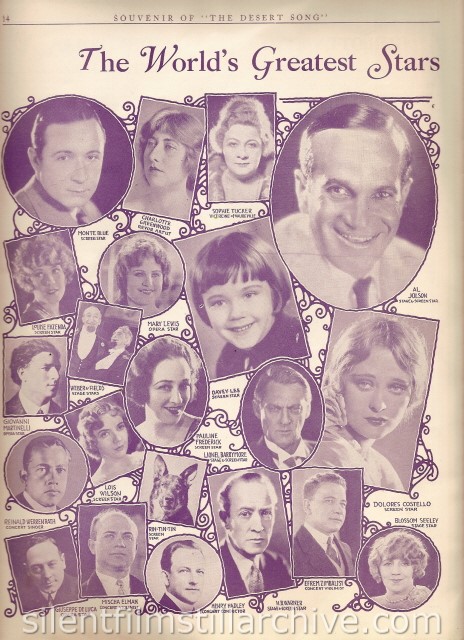
The World's Greatest Stars Are All Vitaphone Stars
MONTE BLUE Screen Star
CHARLOTTE GREENWOOD Revue
Artist
SOPHIE TUCKER Vicerine of Vaudeville
AL JOLSON Stage &
Screen Star
LOUISE FAZENDA Screen Star
MARY LEWIS Opera Star
DAVEY
LEE Screen Star
WEBER & FIELDS Stage Stars
GIOVANNI MARTINELLI
Opera Star
PAULINE FREDERICK Screen Star
LOIS WILSON Screen Star
LIONEL BARRYMORE Stage & Screen Star
DOLORES COSTELLO Screen Star
REINALD WERRENRATH Concert Singer
RIN-TIN-TIN Screen Star
GUISEPPE
DE LUCA Opera Star
MISCHA ELMAN Concert Violinist
HENRY HADLEY Concert
Conductor
H.B. WARNER Stage and Screen Star
EFREM ZIMBALIST Concert
Violinist
BLOSSOM SEELEY Stage Star
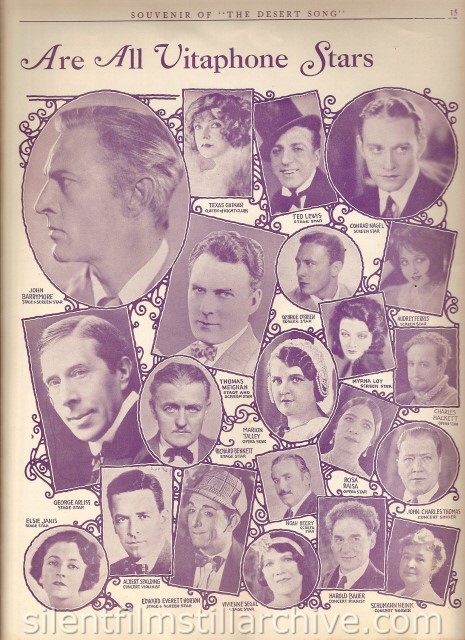
JOHN BARRYMORE Stage & Screen Star
TEXAS GUINAN
Queen of Night Clubs
TED LEWIS Stage Star
CONRAD NAGEL Scren Star
THOMAS MEIGHAN Stage and Screen Star
GEORGE O'BRIEN Screen Star
AUDREY
FERRIS Screen Star
MYRNA LOY Scren Star
GEORGE ARLISS Stage Star
RICHARD BENNETT Stage Star
MARION TALLEY Opera Star
ROSA RAISA Opera
Star
NOAH BEERY Screen Star
JOHN CHARLES THOMAS Concert Singer
ELSIE JANIS Stage Star
ALBERT SPALDING Concert Violinist
EDWARD EVERETT
HORTON Stage & Screen Star
VIVIENNE SEGAL Stage Star
HAROLD BAUER
Concert Pianist
SCHUMANN HEINK Concert Singer
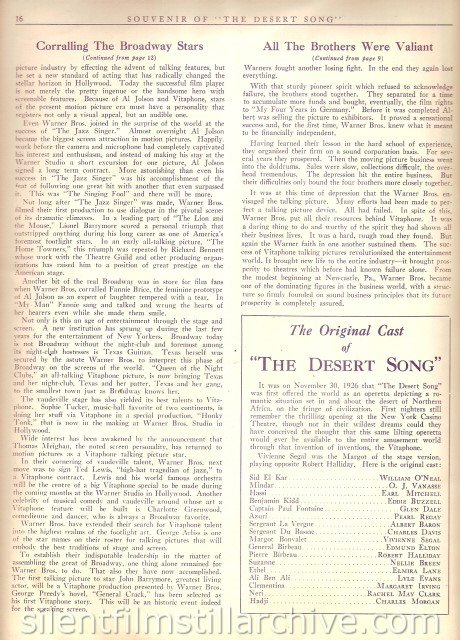
Corralling the Broadway Stars
(continued from page 12)
picture industry by effecting the advent of talking features, but he set a new standard of acting that has radically changed the stellar horizon in Hollywood. Today the successful film player is not merely the pretty ingenue or the handsome hero with screenable features. Because of Al Jolson and Vitaphone, stars of the present motion picture era must have a personality that registers no only a visual appeal, but an audible one.
Even Warner Brothers joined in the surprise of the world at the success of "The Jazz Singer." Almost overnight, Al Jolson became the biggest screen attraction in motion pictures. Happily, work before the camera dna microphone had completely cptivated his interest andenthusiasm, and instead of making his stay the the Warner studio a short excursion for one picture, Al Jolson signed a long erm contract. More astounding than even his success in "The Jazz Singer" was his accomplishment of the feat of folling one great hit with another that even surpassed it. This was "The Singing Fool" and there will be more.
Not long after "The Jazz Singer" was made, Warner Brothers filmed their first production to use dialogue in the pivotal scenes of its dramatic climaxes. In a leading part of "The Lion and the Mouse," Lionel Barrymore scored a personal triumph that outstripped anything during his long career as one of America's foremost footlight stars. In an early all-talking picture, "The Home Towners," this triumph was repeated by Richard Bennett whose work with the theatre Guild and other producing organizations has raised him to a position of great prestige on the American stage.
Another bit of the read Broadway was in store for film fans when Warner Brothers corralled Fannie Brice, the feminine prototype of Al Jolson as an expert of laughter tempered with a tear. In "My Man" Fannie sang and talked and wrung the hearts of her hearers even while she made them smile.
Not only is this an age of entertainment through the stage and screen. A new institution has sprung up during the last few years for the entertainment of New Yorkers. Broadway today is not Broadway without the night-club and foremost among its night-club hostesses is Texas guinan. Texas herself wsa secured by the astute Warner Brothers to interpret this phase of Broadway on the screens of the world. "Queen of the Night Clubs," an all-talking Vitaphone picture, is now bringing Texas and her patter, Texas and her gang, to the smallest town just as Broadway knows her.
The vaudeville stage has also yielded its best talents to Vitaphone. Sophie Tucker, music-hall favorite of two continents, is doing her stuff via Vitaphone in a special production, "Honky Tonk," that is now in the making at Warner Brothers Studio in Hollywood.
Wide interest has been awakened by the announcement that Thomas Meighan, the noted screen personality, has returned to motion pictures as a Vitaphone talking picture star.
In the cornering of vaudeville talent, Warner Brothers next move was to sign Ted Lewis, "high-hat tragedian of jazz," to a Vitaphone contract. Lewis and his world famous orchestra will be the centre of a big Vitaphone special to be made during the coming months at the Warner Studio in Hollywood. Another celebrity of musical comedy and vaudeville around whose art a Vitaphone feature will be built is Charlotte Greenwood, comedienne and dancer, who is always a Broadway favorite.
Warner Brothers have extended their search for Vitaphone talent into the highest realms of the footlight art. Greorge Arliss is one of the star names on their roster for talking pictures that will embody the best traditions of stage and screen.
To establisth their indisputable leadership in the matter of assembling the great of Broadway, one thing alone remained for Warner Brothers to do. That also they have now accomplished. The first talking picture to star John Barrymore, greatest living actor, will be a Vitaphone production presented by Warner Brothers. George Preedy's novel, "General Crack," has been selected as his first Vitaphone story. This will be an historic event indeed for the speaking screen.
All the Brothers Were Valiant
(continued from page 9)
Warners fought another losing fight. In the end they lost everything.
With that sturdy pioneer spirit which refused to acknowledge failure, the brothers stood together. They separated for a time to accumulate more funds and bought, eventually, the film rights to "My Four Years in Germany." Before it was completed Albert was selling the picture to exhibitors. It proved a sensational success and, for the first time, Warner Brothers knew what it meant to be financially independent.
Having learned their lesson in the hard school of experience, they oranized their firm on a sound corporation basis. For several years they prospered. Then the moving picture business went into the doldrums. Sales were slow, collections difficult, the overhead tremendous. The depression hit the entire business. But their difficulties only bound the four brothers more closely together.
It was at this time of depression that the Warner Brothers envisaged the talking picture. Many efforts had been made to perfect a walking picture device. All had failed. In spite of this, Warner Brothers put all their resources behind Vitaphone. It was a daring thing to do and worth of the spirit they had shown all their business lives. It was a hard, rough road they found. But again the Warner faith in one another sustained them. the success of Vitaphone talking pictures revolutionized the entertainment world. It brought new life to the entire industry -- it brought presperity to theatres which before had known failure alone. From the modest beginning at Newcastle, Pa., Warner Brothers became one of the dominating figures in the business world, with a structure so firmly founded onsound business principles that its future prosperity is completely assured.
The Original Cast of "The Desert Song"
It was on November 30, 1926 that "The Desert Song" was first offered the world as an operetta depicting a romantic situation set in an about the desert of Northern Africa, on the fringe of civilization. first nighters still rememer the thrilling opening at the New York Casino Theatre, though no in their wildest dreams could they have conceived the thought that this same lilting operetta would ever be available to the entire amustment world through that envention of inventions, the Vitaphone.
Vivienne Segal was the Margot of the stage version, playing opposite Robert Halliday. Here is the original cast:
|
Sid El Kar |
William O'Neal |
|
Mindar |
O.J. Vanasse |
|
Hassi |
Earl Mitchell |
|
Benjamin Kidd |
Eddie Buzzell |
|
Captain Paul Fontaine |
Glen Dale |
|
Azuri |
Parl Regay |
|
Sergeant La Vergne |
Albert Baron |
|
Sergeant Du Bassac |
Charles Davis |
|
Margot Bonvalet |
Vivienne Segal |
|
General Birbeau |
Edmund Elton |
|
Pierre Birbeau |
Robert Halliday |
|
Suzanne |
Nellie Breen |
|
Ethel |
Elmire Lane |
|
Ali Ben Ali |
Lyle Evans |
|
Clementina |
Margaret Irving |
|
Neri |
Rachel May Clark |
|
Hadji |
Charles Morgan |
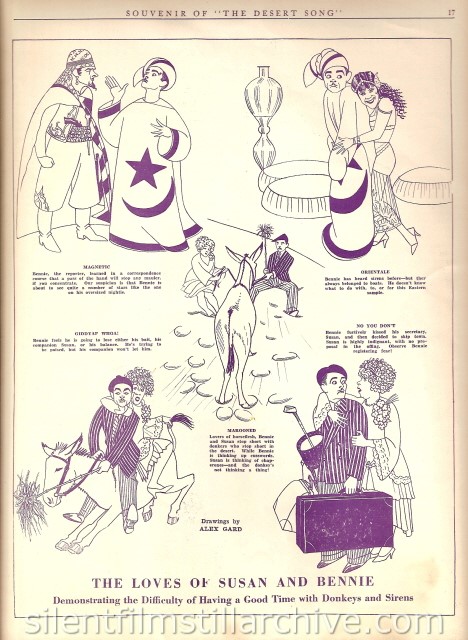
THE LOVES OF SUSAN AND BENNIE
Demonstrating the Difficulty of Having a Good time with Donkeys and Sirens
MAGNETIC
Bennie, the reporter, learned in a correspondence course that a pass of the hand will stop any mauler, if you concentrate. Our suspician is that Bennie is about to see quite a number of stars like the one on his oversized nightie.
ORIENTALE
Bennie had heard sirens before -- but they always beloned to boats. He doesn't know what to do with, to, or for this eastern sample.
GIDDYAP WHOA!
Bennie feels he is going to lose either his bait, his companion Susan, or his balance. He's trying to be poised, but his companion won't let him.
NO YOU DON'T
Bennie furtively kissed his secretary, Susan, and then decided to skip town. Susan is highly indignant, with no proposal in the offing. Observe Bennie registering fear!
MAROONED
Lovers of horseflesh, Bennie and Susan stop short with donkeys who stop short in the desert. While Bennie is thinking up cusswords, Susan is thinking of chaperones -- and the donkey's not thinking a thing!
Drawings by ALEX GARD
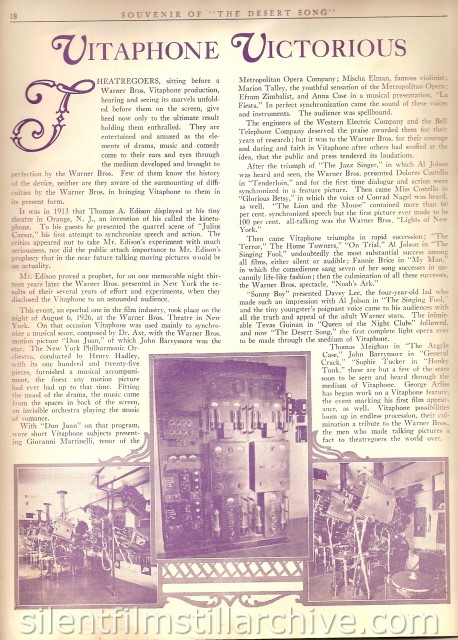
Vitaphone Victorious
Theatregoers, sitting before a warner Brothers Vitaphone production, hearing and seeing its marvels unfolded before them on the screen, give heed now only to the ultimate result holding them enthralled. They are entertained and amused as the elements of drama, music and comedy come to their ears and eyes through the medium developed and brought to perfection by the Warner Brothers. Few of them know the history of the device, neither are they aware of the surmounting of difficulties by the warner Brothers in bringing Vitaphone to them in its present form.
It was in 1913 that Thomas A. Edison displayed at his tiny theatre in Orange, N.J., an invention of his called the kinetophone. To his guests he presented the querrel scene of "Julius Caesar," his first attempt to synchronize speech and action. The critics appeared not to take Mr. Edison's experiment with much seriousness, nor did the public attach importance to Mr. Edison's prophecy that in the near future talking moving pictures would be an actuality.
Mr. Edison proved a prophet, for on one memorable night thirteen years later the Warner Brothers presented in New York the results of their several years of effort and experiments, when they disclosed the Vitaphone to an astounded audience.
This event, an epochal one in the film industry, took place on the night of August 6, 1926, at the Warner Brothers Theatre in New York. On that occasion Vitaphone was used mainly to synchronize a musical score, composed by dr. Axt, with the Warner Brothers motion picture "Don Juan." of which John Barrymore was the star. The New York philharmonic Orchestra, conducted by Henry hadley, with its one hundred and twenty-five pieces, furnished a musical accompaniment, the finest any motion picture ever had up to that time. Fitting the mood of the drama, the music came from the spaces in back of the screen, an invisible orchestra playing the music of romance.
With "Don Juan" on that program, were short Vitaphone subjects presenting Giovanni Martinelli, tenor of the Metropolitan Opera Company; Mischa Elman, famous violinist; Marion Talley, the youthful sensation of the Metropolitan Opera; Efram Zimbalist, and Anna Case in a musical presentation, "La Fiesta," In perfect synchronization came the sound of these voices and instruments. The audience was spellbound.
The engineers of the western Electric Company and the Bell Telephone Company deserved the praise awarded them for their years of research; but it was to the Warner Brothers for their courage and daring and faith in Vitaphone after the others had scoffed at the idea, that the public and press tendered its laudations.
After the triumph of "The Jazz Singer," in which Al Jolson was heard and seen, the Warner Brothers presented Dolores Costello in "Tenderloin," and for the first time dialogue and action were synchronized in a feature picture. Then came Miss Costello in "Glorious Betsy," in which the voice of Conrad Nagel was heard as well. "The Lion and the Mouse" contained more than 60 per cent. synchronized speech but the first picture ever made to be 100 per cent. all-talking was the Warner Brothers "Lights of New York."
Then came Vitaphone triumphs in rapid succession; "The Terror," "The Home Towners," "On Trial," Al Jolson in "The Singing Fool," and the tiny youngster's poignant voice came to his audiences with all the truth and appeal of the adult Warner stars. The inimitable Texas Guinan in "Queen of the Night Clubs" followed, and now "The Desert Song," the first complete light opera ever to be made through the medium of Vitaphone.
Thomas Meighan in "The Argyle Case," John Barrymore in "General Crack," Sophie Tucker in "Honky Tonk," these are but a few of the stars soon to be seen and heard through the medium of Vitaphone. George arliss has begun work on a Vitaphone feature, the event marking his first film appearance, as well.
Vitaphone possibilities loom up in endless procession, their culmination a tribute to the Warner Brothers, the men who made talking pictures a fact to theatregoers the world over.
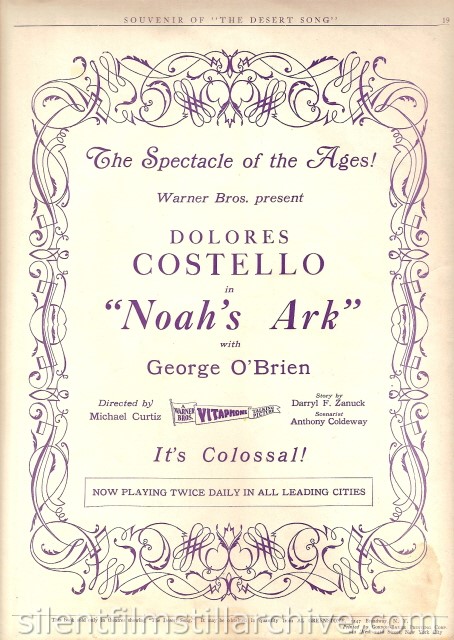
The Spectacle of the Ages
Warner Bros. present
DOLORES COSTELLO in
Noah's Ark
with George O'Brien
Directed by Michael Curtiz
Story by Darryl F. Zanuck
Scenarist Anthony Coldeway
It's Colossal
NOW PLAYING TWICE DAILY IN ALL LEADING CITIES
This book is sold only in theatres showing "The Desert Song." It may be obtained in quantity from AL GREENSTONE, 1547 Broadway, N. Y.
Printed by GORDON-BAKER Printing Company, 142 West 24th Street, New York City
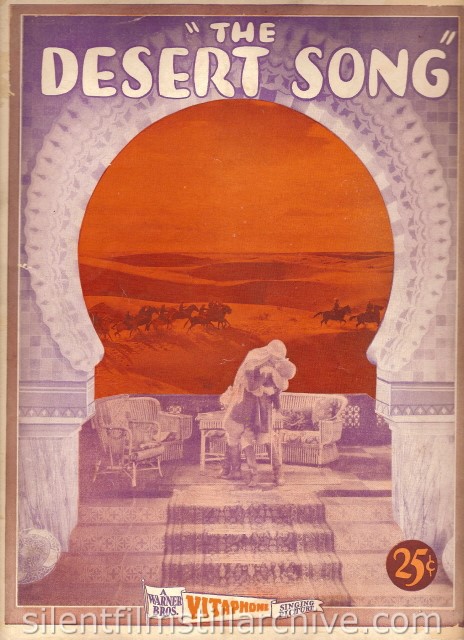
Desert Song, The (1929) with John Boles and Carlotta King. Directed by Roy Del Ruth. Warner Brothers.
Books
(none)
Last Modified September 21, 2023



















